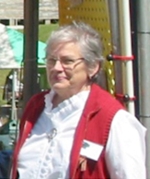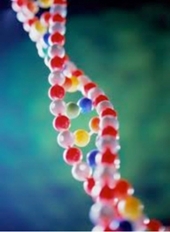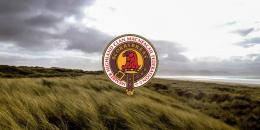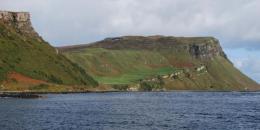DNA Testing: Projects for the Clan MacNicol
By Anne Nicholson Crocker
 Anne Crocker |
As every genealogist knows, gathering family lore and photographs adds indispensable color and personality to our ancestors. By researching data, digging up details, and collecting archival the documents that support them, we form the backbone of our family history. Now by DNA testing we can use science to take it one step further, adding bloodlines to complete the family so carefully reconstructed.
DNA testing for genealogical purposes does not actually test blood. Today we use swabs to gather a few cells from the insides of the cheeks. The material gathered is then processed to extract the DNA that has been passed down to us generation by generation.
Remember the days when family researchers had to travel to each courthouse, hand copying data? Then came microfiche and film, with state archives collecting artifacts and fragile documents, making genealogy harder on the eyes perhaps but a lot less tedious. What a boon the photo copiers were! Now most of us use computers and pocket sized do it all phones almost as an extension of our minds, perfect for a quick check on a name or date. We use the internet for all kinds of genealogical searches, thankful for a wonderful bounty of documents and histories, although frustrated when misinformation and error spread so easily. Is there anyone who does not benefit greatly from these new tools?
Now there is another tool that is available for us to learn to use, exceedingly reliable and most beneficial. Does it promise instant solutions? Well, yes and no. As with all these new tools, we have to learn to make them function optimally. And there is work involved.
After the years of digging into wills, deeds, land transactions, census records, and family Bibles to put together family histories bringing us closer to our origins, DNA seems to work like magic with little expensive of energy from us. A test actually gives immediate results, although the results may not be as useful as we expected. And that is because we hoped to meet by chance another person just like us. Not a great likelihood in real life where random numbers of people are thrown together (think of a convention, a cruise, a theater evening) and certainly not if only three or four hundred people with similar surnames chance to order DNA testing.
This is the way the magic acts with a random pool of participants: if we take a large room full of a thousand men having the same basic surname and test them on the crucial 37 markers of a Y-DNA test, the results would immediately sort them out by matching family groups. Beautifully simple! But the names we derive from Nicol with all those variant spellings have many origins. So we might expect to find well over a hundred different family groupings from these thousand random men, perhaps double that. Even so, not all the men would have matches in the room.
 Their family may have adopted the surname late or might be limited in numbers, especially males. Moreover, statistics from the database of all surnames show that some ten to fifteen percent of men have a break in their surname ancestry, perhaps from an adoption, a name shift, an unreported or unremembered "non-paternity event" as it is curiously called. Most of us anticipate running into a biological cousin with another surname, say McLeod, but it may be surprising to discover we match more Skeens or Goodlets than Nicols.
Their family may have adopted the surname late or might be limited in numbers, especially males. Moreover, statistics from the database of all surnames show that some ten to fifteen percent of men have a break in their surname ancestry, perhaps from an adoption, a name shift, an unreported or unremembered "non-paternity event" as it is curiously called. Most of us anticipate running into a biological cousin with another surname, say McLeod, but it may be surprising to discover we match more Skeens or Goodlets than Nicols.
There are many reasons for these shifts in biological history, most of them quite understandable, given migrations, female death rates, and the frontier or hardscrabble existence of many of our forebears. When a participant discovers himself in one of these family groupings based on Y-DNA testing, he can seize the opportunity to compare notes on family history with the new found cousins. Many are able to discover overlaps in places or names or migration patterns that lead to understanding the relationship. Some discover physical likenesses and family traits. Some wonder just how close the kinship can be, if there are no obviously points in common. And that should stimulate more archival research and possibly more DNA testing, with more planning and less randomness involved.
Our Nicholson and Nichols DNA projects are with a company based in Houston, Texas: FamilyTreeDNA. The variants of the surname McNichol are included in both projects. Not only is the company highly stable and reliable, the staff are friendly and well prepared to help any participant.
 There are excellent explanations of the various DNA tests and their uses on the FamilyTreeDNA.com FAQs webpages complete with dictionaries and illustrations, but I will attempt to give you a brief overview from my experiences as a project administrator. More help is available through the user groups at Yahoo, especially the Newbie group. The most commonly used DNA test is the Y-DNA set of test batteries, the one we would have used to sort out that room full of a thousand Nicol variant surnamed men.
There are excellent explanations of the various DNA tests and their uses on the FamilyTreeDNA.com FAQs webpages complete with dictionaries and illustrations, but I will attempt to give you a brief overview from my experiences as a project administrator. More help is available through the user groups at Yahoo, especially the Newbie group. The most commonly used DNA test is the Y-DNA set of test batteries, the one we would have used to sort out that room full of a thousand Nicol variant surnamed men.
This is a test for men only, as only men have the Y chromosome. It tests a portion of Y-DNA for some unique bits passed down from father to son, just as the surname is passed along. The results of such a limited DNA test cannot be used to identify a particular individual. The same Y-DNA bits are shared by every male of that paternal family: fathers, sons, uncles, nephews, grandfathers all descending from one patriarch. In effect, the Y-DNA test is a surname test that identifies sub groups within the same surname, based on the unique DNA pattern or haplotype of the ultimate patriarch.
Since a man receives his father's Y-DNA with almost no variation, any testing of a grandfather, his two sons, and four male children of those sons should yield results that are nearly identical when 12, then 25, then 37, and ultimately 67 markers are matched. There is a tendency for the Y-DNA to spontaneously mutate on a marker or two every three to five generations. These mutations may result, in the theoretical 6 sons and grandsons matching the grandfather say 67/67, 65/67, 66/67, 67/67, 65/67, and 64/67. Men with the same surname but from a different family might match on only 47 of 67 markers or 55/67 or 39/67. If, however, a Skeen matches this Nicol group 64/67, he and the Nicols share a common paternal ancestor.
What the numbers above represent are quantity of markers that match between two participants (say 47) versus total quantity of markers tested (say 67). Because our eyes are not used to distinguishing sets of numbers as readily as sets of letters, when you begin to look at compared test results, you can be momentarily bewildered. For each participant, each marker or locus on the DNA test sequence has a numerical value, the number representing a count of short tandem repeats or STR's. These are literally little repeating patterns of the DNA building blocks, rather like a sequence of adjoining boxcars on a train preceded and followed by cars of a different type. type. The scientist sees, for example …cgatATGCATGCATGCATGCATGCtgca… and tallies up five repeats for the pattern ATGC.
The DNA results are posted as a sequence of these tallies for the sets of markers. When you click on the results charts on the DNA projects' webpages, remember to select the colorized results so that the differences in these counts pop out. It is the differences that help us sort out the families.
In the examples below, we see two sets of DNA test results. Although these numbers look close at first glance, a quick comparison with the differences highlighted clearly shows that we have men from two different biological patriarchs.
The first set of loci or markers 1 - 12 shows matches on 11 of 12, a promising match:
13 24 14 11 11-14 12 12 12 13 13 29
13 24 14 11 11-14 12 12 12 13 13 30
Markers 13 - 25 show 6 markers with differing counts:
17 9-10 11 11 24 16 19 29 14-15-16-16
18 9 - 9 11 11 26 15 19 29 15-15-15-17
Markers 26 - 37 are off on an additional 7 markers, with clearly no match:
11 11 19-23 14 15 18 16 36-37 12 12
11 12 19-23 15 15 17 18 35-38 11 12
Although the first participant above actually had eighteen 11/12 matches to others in the Nicholson project, none of the eighteen continued through 25 and 37 markers. He had over twenty-five hundred 12/12 matches from the entire database of all surnames, but even the dozen 25 marker matches disappeared when 37 markers were tested.
Within a matching family group, however, there are fewer of the differences or mutations. Looking at the full array of 37 markers, we see sets that match as clearly as we could see the obvious lack of match above. This group a couple known cousins who chanced to match random participants.
Person 1: 13 24 14 11 11-14 12 12 12 13 12 30 18 9-9 11 11 26 15 19 29 15-15-15-17 11 12 19-23 15 15 17 18 35-38 11 12
Person 2: 13 24 14 11 11-14 12 12 12 13 13 30 18 9-9 11 11 26 15 19 29 15-15-17 17
Person 3: 13 24 14 11 11-14 12 12 12 13 13 30 18 9-9 11 11 26 15 19 29 15-15-17-17 11 12 19-23 15 15 18 18 35-38 11 12
Person 4: 13 24 14 11 11-14 12 12 12 13 13 30 18 9-9 11 11 26 15 19 29 15-15-17-17 11 12 19-23 15 15 18 18 35-38 11 12
One of the participants (Person2) chose to test only 25 markers, with the others having at least 37 markers. He was fortunate to have a very stable DNA that shows few mutations over the several generations represented here. This leads to an important question: How many markers should one test to assure that any "matches" among participants show a true kinship?
The first set of 12 markers is used to predict the haplogroup into which the participant falls. The haplogroup is an ancient subgrouping of humankind that to some degree tells the participant his geographic origins about the time of the last Ice Age. Most of the participants within the Nicholson and Nichols groups belong to the two most common British haplogroups: R1b1 and I1 or I2, with only a few participants from haplogroups E, G, and J. The R groups are commonly referred to as Western Atlantic (middle coast of Europe--a broad range), with the I groups often called Nordic. The I groups and R groups are well distributed throughout the British Isles. You can find literature about the origins and migrations of these ancient subgroups, much of it on the web. Other than the FamilyTreeDNA.com FAQs pages, there are the exciting pages found on the webpages of National Geographic's World Genographic project, a study also using the facilities of FamilyTreeDNA. Haplogroups are obviously important to genealogists; if you do not belong to the same Ice Age clan, you certainly are not of the same modern age paternal or surname family.
As we have seen from the examples above, those participants known to come from the British Isles can have thousands of perfect or nearly perfect matches at twelve markers, both within the same surname as well as to many different surnames. Twelve marker results are what we could call Deep Roots matches. These are the tests commonly used by National Geographic and anthropologists exploring migrations of population groups six thousand or more years ago.
Since the consistent use of surnames did not arise until well after the Middle Ages, we need a level of testing that can eliminate our several thousand year old cousins and can bring us closer to those within recorded historical time frames. Keep in mind that surnames were not so sacrosanct in some of the far flung corners where our ancestors lived. Names were changed for political and financial advantage and sometimes for survival itself.
For genealogical purposes, especially with our Nicol variant surnames, we need to do Y-DNA testing on at least 37 markers. If we are exploring a possible relationship match between two different surnames, say a McDonald and a Nicolson that match 35/37, we need to up the test batteries to 67 markers. Recently Family Tree DNA has added an upgrade for a total of 111 markers; the additional sets will, we hope, help us identify branches within family groups and help us more nearly pin down a generational date for the most recent common ancestor.
So far there are slightly over a hundred Y-DNA test participants in the Nicholson project, about eighteen additional participants in a private Nicholson-2 DNA project, and some two hundred forty participants in the Nichols project, which includes some McNichol variant names. There is also a Nixon/Nickson project and a McNeill project with some potential matches to participants in the other Nicol variant surname projects. A Nickerson project with about 35 participants has so far produced no obvious matches to the other groups.
Why should you use DNA testing to support and supplement your careful archival research? For the same reasons you need wills and census records to confirm family lore. Any genealogy is a frame of theories which you prove with increasing levels of data and tests. Because your DNA is a composite of all the people who made up you, it is your genealogy contained in a few buccal cheek cells. You can document the DNA pattern that is unique to your family. In fact, with only five or six carefully chosen test participants (after some rather intense work to find them), you can say with assurance that you have the Y-DNA signature or haplotype of your fifth or sixth great grandfather. The exciting but hard research depends on your being able to track down descendants of collateral lines. The DNA testing adds the authority of scientific proof.
You will definitely make a few unexpected discoveries. Be sure that you do all the careful archival research on anyone you test. When one participant of a family group we were building did not match a 37 marker test, we discovered belatedly that the one census images we had not examined carefully included the notation "s-son" (i.e. step-son)by a child reportedly 8 years old, faint but unmistakable. The child appeared in his widowed mother's household ten years earlier as an infant with his biological father's surname. Small wonder that his descendant did not match. Even in very recent generations unreported adoptions may crop up. And census ages are never quite reliable enough to determine the true parents of a child.
DNA testing is probably one of the overall least expensive items in our list of genealogical purchases. The cost of a test is about what a day's trip to a state archives building, with gas, parking, card fees, copying charges, meals quickly adding up. And the book and CD purchases mount up quickly. At FamilyTreeDNA usually twice a year, during June and December, there are tempting price reductions in new kits and upgrades.
Please look at the web pages and results pages of our Nicholson and Nichols projects. The co-administrators Emma Lou Nicholson Weldon and Anne Nicholson Crocker for the Nicholson project and Brian Hamman for the Nichols project welcome your questions and your participation.
To find out more, go to FamilyTreeDNA.com and put your surname in the search window. The search should take you to these links for the Nicholson Project at
http://www.familytreedna.com/group-join.aspx?Group=Nicholson
and the Nichols Project at
http://www.familytreedna.com/group-join.aspx?Group=Nichols
Those of you with the McNichol variant surnames may join either project. In fact, once you have your results, you may discover that you have matches to participants in both of the projects. There is, however, less matching between a short Nicol name and the Nicholson variants than one might expect, given that all to common tendency for clerks to shorten the name in documents.
Do explore the DNA project webpages. Do think of those knotty genealogical problems that might be solved by using DNA. Do ask questions. But above all, do order a DNA kit to honor that oldest living kinsman. It will flatter him to have the chance to represent all the males who preceded and follow him. It will be a memorable for you and ultimately rewarding for the whole family.
Anne Nicholson Crocker
Concord, NC
[email protected]
Note: If you are a clan member who has already had a Y-DNA test from Family Tree DNA, please let Anne know your Sample Number, so she can keep track of our groups and look for matches.







